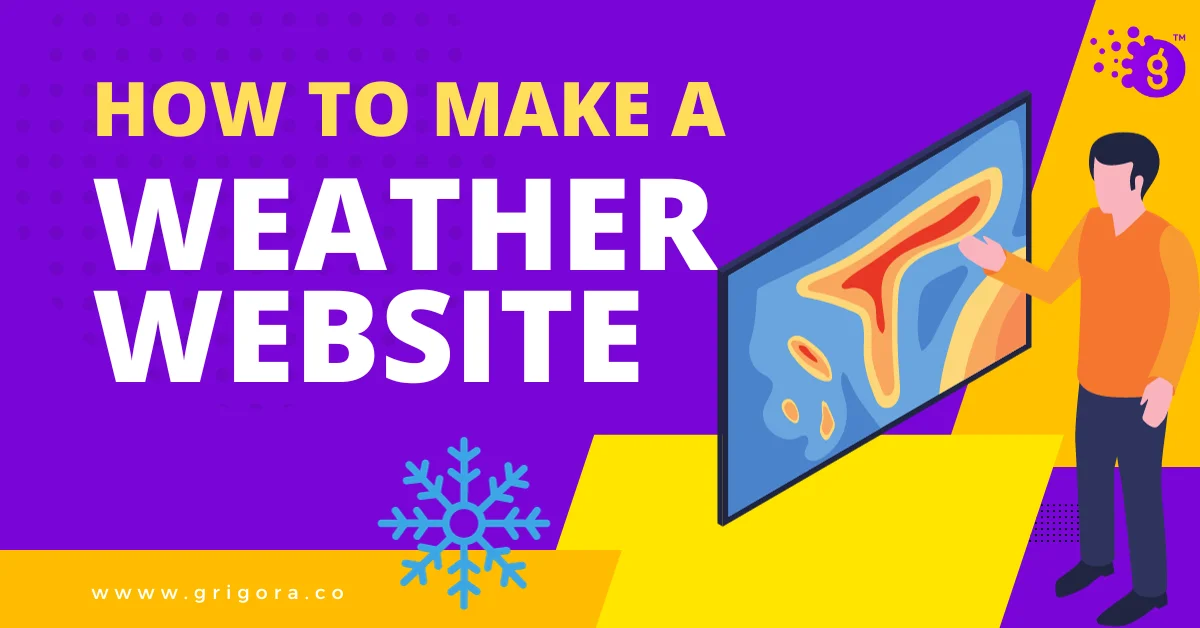Introduction
Climate is what we expect, weather is what we get.
Mark Twain
In today's fast-paced world, weather websites serve as a crucial tool for planning our day-to-day activities. Whether you're a farmer, a commuter, or just someone looking to plan a weekend getaway, accurate and timely weather information is invaluable. This article aims to guide you through the process of creating your own weather website, a venture that not only serves a public good but can also be quite rewarding.
The Importance of Weather Websites
Weather websites are more than just a convenience; they are a necessity in our daily lives. They provide critical information that helps individuals and organizations make informed decisions. For example, airlines rely on weather forecasts to plan flights, and event organizers need to know the weather to make last-minute adjustments.
Different Types of Weather Websites
There are various types of weather websites, ranging from simple platforms that offer basic weather forecasts to complex systems that provide in-depth meteorological data, including satellite images, wind patterns, and more.
Why You Should Consider Building a Weather Website
Creating a weather website can be a fulfilling project that serves a broad audience. With the right set of tools and a well-thought-out approach, your website can become a go-to resource for weather information.
Choosing the Right Technology Stack
Selecting the appropriate technology stack is a pivotal step in the development of your weather website. The technology stack is the combination of programming languages, frameworks, and tools that will be used to construct and operate your website.
Frontend Technologies: HTML, CSS, JavaScript
The frontend is the part of the website that users interact with directly. HTML (HyperText Markup Language) is used for structuring your web content. CSS (Cascading Style Sheets) is used for design and layout, while JavaScript is used for making web pages interactive.
Backend Technologies: Node.js, Python, PHP
The backend is where the website's logic is stored. You have various programming languages to choose from for this, such as Node.js, Python, or PHP. Each of these languages has its own set of frameworks that can expedite the development process.
Database Choices: MySQL, MongoDB
For storing user data and other dynamic elements, a database is necessary. MySQL is a widely-used relational database, whereas MongoDB is a popular choice for those who prefer a NoSQL database. The choice between the two will depend on your specific data needs and the types of queries you'll be running.
Data Sources and APIs
Weather websites are heavily dependent on real-time, accurate data, which is usually sourced through APIs (Application Programming Interfaces).
Free Weather APIs: OpenWeather, Weatherstack
Several free APIs, such as OpenWeather and Weatherstack, offer basic weather information. These are excellent choices for smaller projects or initial stages of website development.
Paid Weather APIs: The Weather Company, Climacell
If you require more comprehensive data and features, you might opt for paid APIs from providers like The Weather Company or Climacell. These services offer more in-depth meteorological data and often provide better customer support.
How to Choose the Right API for Your Needs
The selection of an API will be influenced by the specific needs of your website and your budget. Important factors to consider include the accuracy of the data, how frequently it's updated, and the geographical areas it covers.
Design and Layout: The Cornerstone of User Experience
When it comes to creating a weather website, the design and layout serve as the cornerstone of the user experience. The design is not merely an aesthetic choice; it's a functional one that directly impacts how easily users can access and interpret the weather data you provide.
Creating a User-Friendly Interface: The Gateway to User Retention
The user interface is the gateway to your website, and its design can significantly influence user retention. An intuitive, user-friendly interface is essential for guiding visitors through the wealth of information available. To achieve this, consider employing a minimalist design that eliminates clutter and focuses on ease of navigation. Use a straightforward menu that categorically divides the website into essential sections like 'Current Weather,' 'Hourly and Daily Forecasts,' and 'Interactive Weather Maps.' Icons and labels should be easily recognizable, and a card-based layout can help compartmentalize different types of weather data, making it easier for users to find what they're looking for.
Mobile Responsiveness: Meeting the Needs of a Diverse User Base
In an era where mobile internet usage has surpassed desktop, your website's mobile responsiveness is not just an add-on but a necessity. A responsive design ensures that your website's layout adapts to different screen sizes, offering a consistent and seamless user experience across various devices, including smartphones, tablets, and desktop computers. This adaptability is crucial for catering to a diverse user base with varying access to technology.
Design Elements: Enhancing User Experience Through Visual Cues
Visual elements play a pivotal role in enhancing the user experience. High-quality icons, graphics, and interactive maps can serve as effective visual cues, enabling users to quickly grasp complex weather data. For example, a well-designed icon can instantly convey if it's sunny, cloudy, or rainy, eliminating the need for textual explanation. Similarly, interactive maps can provide a dynamic, real-time view of weather patterns, adding an engaging element to your website.
Core Features: What Makes Your Weather Website Indispensable
The core features of your weather website are what will make it indispensable to users. These features are not just bells and whistles but essential components that provide real value to your audience.
Current Weather Conditions: Serving Immediate User Needs
Providing real-time data on current weather conditions is non-negotiable. This section should be comprehensive, offering not just temperature readings but also other crucial metrics like humidity, wind speed, and air quality. The data should be presented in an easily digestible format, perhaps with the aid of graphs or charts for more detailed analysis.
Weather Forecasts: A Comprehensive Look into the Future
A weather website should be more than a snapshot of current conditions; it should serve as a comprehensive resource for planning ahead. Offering forecasts that range from short-term hourly updates to long-term weekly or even monthly predictions adds depth and utility to your website.
Interactive Maps and Radar: Adding a Dynamic Layer to Weather Reporting
Interactive maps and radar features can add a dynamic layer to your weather reporting. These tools can provide real-time updates on weather patterns, track the movement of storms, and offer severe weather alerts, making your website a comprehensive weather solution.
User Experience: The Key to Building a Loyal Audience
User experience is not just a buzzword; it's the key to building a loyal audience for your weather website. A well-designed, user-friendly website can turn casual visitors into regular users, and regular users into loyal advocates for your brand.
Search Functionality: Making Information Accessible
One of the most critical aspects of user experience is how easily users can find the information they're looking for. A robust search functionality can make your website incredibly user-friendly. Allow users to search for weather conditions by city, zip code, or even geographic coordinates. Auto-suggest features can speed up the search process, and search history could make it easier for returning visitors.
User Customization: Personalizing the Weather Experience
Personalization can significantly enhance user engagement. Allow users to customize settings such as measurement units (Celsius or Fahrenheit), language, and even themes. These personalized settings can be saved for returning users, offering a tailored experience that can set your website apart from competitors.
Error Handling and User Feedback: Building Trust Through Transparency
No website is perfect, and users understand that. What matters is how you handle errors and glitches. Transparent error handling and clear messaging can build trust. For instance, if the weather data for a particular location is not available, a clear message explaining the issue can be more effective than a generic error page. Additionally, offering users a channel for feedback can not only provide you with valuable insights but also make users feel heard.
SEO and Traffic Generation: The Lifeline of Your Website's Success
In today's digital age, having a great website is not enough; people need to find it. Search Engine Optimization (SEO) and traffic generation strategies are the lifelines of your website's success.
Keyword Optimization: Making Your Website Search Engine Friendly
Keyword optimization is crucial for making your website search engine friendly. Research relevant keywords that potential users might use to search for weather information and incorporate them naturally into your website's content, meta descriptions, and even image alt texts.
Backlink Strategies and Guest Blogging: Building Authority
Backlinks from reputable websites can significantly boost your website's SEO. Consider guest blogging on weather-related or local community websites to build authority and gain valuable backlinks.
Social Media Promotion: Expanding Your Reach
Social media platforms can serve as powerful channels for driving traffic to your website. Regular updates featuring current weather conditions, forecasts, and even weather-related tips and trivia can engage a broader audience and direct them to your website for more detailed information.
Monetization Strategies: Turning Traffic into Revenue
Once you've built a solid user base and are generating consistent traffic, it's time to think about monetization. Monetization is the process of converting your website's traffic into revenue, and there are several strategies you can employ to achieve this.
Affiliate Marketing: Leverage Your Content
Affiliate marketing is a popular monetization strategy that involves promoting products or services in exchange for a commission on sales generated through your unique affiliate link. For a weather website, you could partner with companies that sell weather-related products like raincoats, umbrellas, or even weather stations.
Subscription Models for Premium Features: Add Value to User Experience
Offering premium features against a subscription fee can add a valuable revenue stream. You could offer ad-free experiences, more detailed weather reports, or even specialized forecasts like agricultural or marine forecasts as part of your premium package.
Ad Networks and Direct Advertising: Maximize Your Ad Revenue
Ad networks like Google AdSense can be a straightforward way to generate revenue. These networks automatically display ads that are relevant to your content and audience. Direct advertising can also be a lucrative option if you have a substantial user base. Companies may pay to place their ads on your website, especially if your audience aligns with their target market.
Analytics and Performance Tracking: Measure, Analyze, Improve
Understanding your website's performance is crucial for its long-term success. Analytics can provide you with insights into user behavior, page views, and much more.
Monitoring User Engagement: Know Your Audience
User engagement metrics such as average session duration, bounce rate, and pages per session can provide valuable insights. These metrics can help you understand what's working and what needs improvement.
Tracking API Usage: Manage Your Resources
If you're using third-party APIs for weather data, it's essential to monitor API usage to ensure you're not exceeding any limits. This can also help you decide if you need to upgrade your API plan.
Adjusting Strategies Based on Analytics: Data-Driven Decisions
Regularly reviewing your analytics and making data-driven decisions can significantly improve your website's performance and user experience. For example, if you notice that a particular type of content is performing well, you might decide to produce more of that content.
Legal and Ethical Considerations: Navigating the Rules
When it comes to running a weather website, there are several legal and ethical considerations to keep in mind. Being aware of these aspects is crucial to avoid any legal complications and to maintain your website's credibility.
Data Privacy and User Consent: Protecting User Information
Data privacy is a critical concern, especially if your website collects user data for personalized forecasts or other features. Make sure to have a clear privacy policy that outlines how you collect, use, and store user data. Also, it's essential to obtain user consent before collecting any personal information.
Attribution for API and Other Data Sources: Give Credit Where It's Due
If you're using third-party APIs or data sources, make sure to provide the necessary attribution as required by the terms of service. Failing to do so can result in legal issues and can get your API access revoked.
Terms of Service and Privacy Policy: Set the Rules of Engagement
Having a well-drafted Terms of Service and Privacy Policy is not just a legal requirement but also builds trust with your users. These documents should clearly outline the rules, terms and legal limitations of using your website and its services.
FAQs: Your Questions Answered
How much does it cost to build a weather website?
The cost of building a weather website can vary widely depending on the features you want to include, the data sources you use, and the technology stack. Free APIs and open-source technologies can minimize costs, but specialized features may require a budget.
Do I need a background in meteorology?
While a background in meteorology can be beneficial, it's not strictly necessary. Many reliable weather APIs provide accurate and comprehensive data that you can use. However, understanding basic weather terms and concepts can improve the quality of your content.
How do I ensure the accuracy of the weather data?
Ensuring data accuracy is crucial for the credibility of your weather website. Always use reputable and reliable data sources and APIs. Some providers offer accuracy metrics that can help you gauge the reliability of the data.
What are the limitations of free weather APIs?
Free weather APIs often come with limitations such as fewer API calls, less detailed data, or delayed updates. If your website gains traction, you may need to consider switching to a paid plan for more comprehensive data and higher request limits.
How can I make my weather website stand out from the competition?
Unique features, user-friendly design, and accurate, timely information can make your weather website stand out. Consider adding interactive maps, real-time alerts, and community features to engage your audience.
Conclusion: The Journey of Building a Weather Website
Creating a weather website is a multifaceted endeavor that involves various aspects, from choosing the right technology stack to implementing effective monetization strategies. It's a rewarding experience that not only allows you to delve into an exciting field but also provides numerous opportunities for growth and revenue generation.
Choosing the Right Blogging Format for You
Your choice between microblogging and personal blogging will depend on your goals, the kind of content you want to create, and how you want to engage with your audience. Both formats have their pros and cons, and the best choice will depend on your specific needs and objectives.
Future Trends in Weather Website Development
As technology continues to evolve, we can expect to see more advanced features like AI-driven forecasts, real-time weather updates, and even integration with smart home systems.
Next Steps for Aspiring Weather Website Developers
If you're inspired to build your own weather website, the next step is to start planning. Use this article as a guide to navigate through each stage of development, from conceptualization to monetization.



